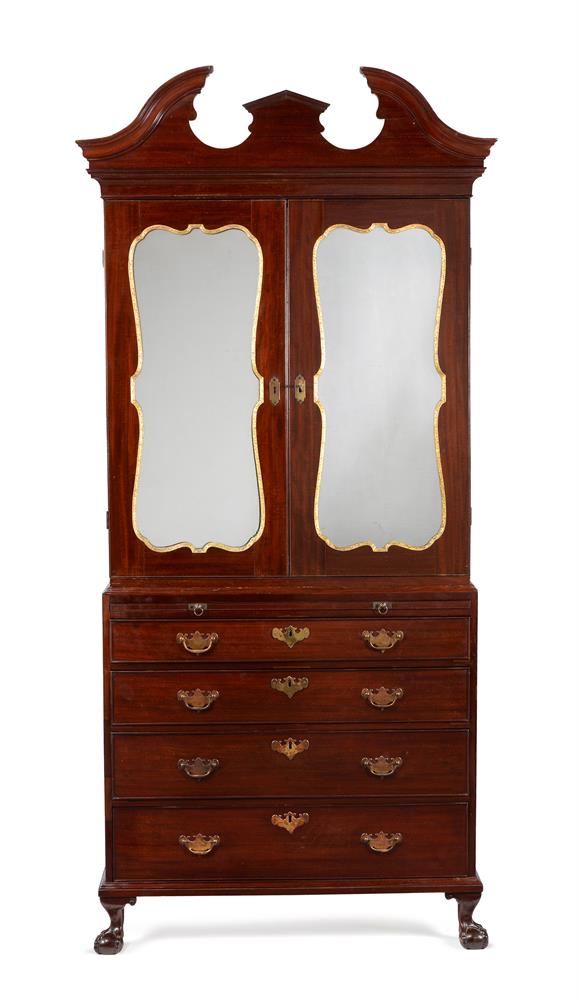An Irish George II carved and gilt-gesso pier mirror, possibly by John and Francis Booker circa 1740, the triangular pediment centred by a Roman helmet and laurel leaves surrounded by dentil and egg and dart mouldings, the associated rectangular plate flanked by fluted composite pilasters above Vitruvian scroll decoration and a shell-centred shaped apron, 189cm high, 115cm wide, Provenance: Possibly supplied to Speaker Connolly for Castletown, Co. Kildare London Art Market, 1960s The bold Palladian form of this 'looking glass' shares similarities with documented mirrors produced by the leading Dublin firm of 'Looking Glass Merchants', 'glass-grinders' and 'glass sellers' established by the brothers Francis and John Booker. They traded from premises in Essex Bridge, Dublin where their father is recorded as early as 1715. Francis Booker was appointed Lord Major of Dublin in 1772 but died the same year. The business continued operating from the same address until 1786 when John moved his workshops to Jervis Street shortly before his death three years later. The design of the Bookers' mirrors was based on patterns for mirrors illustrated in William Jones's 'The Gentleman or Builders Companion containing a variety of useful designs for doors, gateways, peers, pavilions, temples, chimney-pieces, slab tables, pier glasses, or tabernacle frames, ceiling pieces etc.', 1739 (see The Knight of Glin & J. Peill, Irish Furniture, New Haven and London, 2007, fig. 193). Jones's book was available during the same year at Robert Owen Skinners Row where a copy may possibly have been acquired by the Bookers at 6 Essex Bridge. Castletown House, County Kildare, Ireland, is a Palladian country house built in 1722 for William Conolly, the Speaker of the Irish House of Commons. It formed the centrepiece of a 550-acre estate. Conolly was the most important of the Undertakers, the managers of Government business in the Irish House of Commons, in the early 18th century. He was associated with the moderate faction of Whigs and was opposed by the Brodrick faction from Cork. He was a Member of Parliament for Donegal Borough from 1692 to 1703 and subsequently for Londonderry County until his death in 1729. In the designing of Castletown he specified that every part of it, including its furniture had to be made from Irish materials.
An Irish George II carved and gilt-gesso pier mirror, possibly by John and Francis Booker circa 1740, the triangular pediment centred by a Roman helmet and laurel leaves surrounded by dentil and egg and dart mouldings, the associated rectangular plate flanked by fluted composite pilasters above Vitruvian scroll decoration and a shell-centred shaped apron, 189cm high, 115cm wide, Provenance: Possibly supplied to Speaker Connolly for Castletown, Co. Kildare London Art Market, 1960s The bold Palladian form of this 'looking glass' shares similarities with documented mirrors produced by the leading Dublin firm of 'Looking Glass Merchants', 'glass-grinders' and 'glass sellers' established by the brothers Francis and John Booker. They traded from premises in Essex Bridge, Dublin where their father is recorded as early as 1715. Francis Booker was appointed Lord Major of Dublin in 1772 but died the same year. The business continued operating from the same address until 1786 when John moved his workshops to Jervis Street shortly before his death three years later. The design of the Bookers' mirrors was based on patterns for mirrors illustrated in William Jones's 'The Gentleman or Builders Companion containing a variety of useful designs for doors, gateways, peers, pavilions, temples, chimney-pieces, slab tables, pier glasses, or tabernacle frames, ceiling pieces etc.', 1739 (see The Knight of Glin & J. Peill, Irish Furniture, New Haven and London, 2007, fig. 193). Jones's book was available during the same year at Robert Owen Skinners Row where a copy may possibly have been acquired by the Bookers at 6 Essex Bridge. Castletown House, County Kildare, Ireland, is a Palladian country house built in 1722 for William Conolly, the Speaker of the Irish House of Commons. It formed the centrepiece of a 550-acre estate. Conolly was the most important of the Undertakers, the managers of Government business in the Irish House of Commons, in the early 18th century. He was associated with the moderate faction of Whigs and was opposed by the Brodrick faction from Cork. He was a Member of Parliament for Donegal Borough from 1692 to 1703 and subsequently for Londonderry County until his death in 1729. In the designing of Castletown he specified that every part of it, including its furniture had to be made from Irish materials.















Testen Sie LotSearch und seine Premium-Features 7 Tage - ohne Kosten!
Lassen Sie sich automatisch über neue Objekte in kommenden Auktionen benachrichtigen.
Suchauftrag anlegen